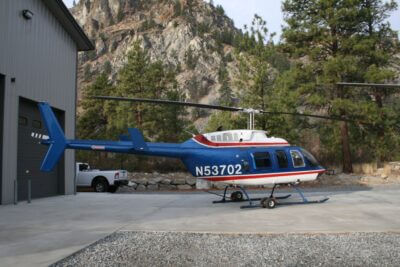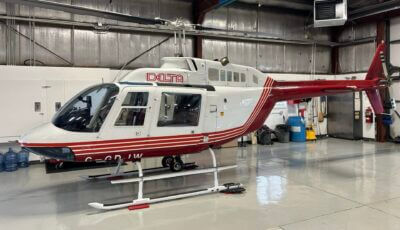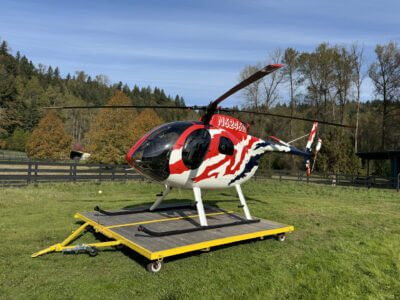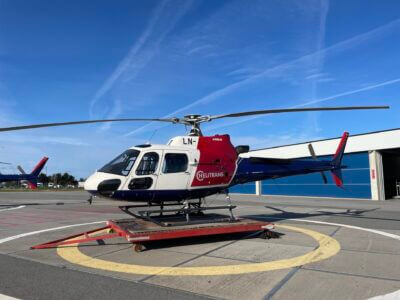BUYING A HELICOPTER
Shipping options: How to get your helicopter smoothly delivered in 2024
What impact has the changing geopolitical landscape had on how operators ship their aircraft around the world? We spoke to shipping specialists to find out.

By: Treena HeinPosted on: September 30, 2024
Operators have been shipping their helicopters between continents for a very long time, both by air and ocean liner. Despite some recent global developments, companies are working hard to ensure the continued efficiency of these transit routes, with peace of mind for customers the top priority.
While there may be reduced opportunity for shipping by air between some regions these days, new oceanic options have opened up over the last three years, and are now well-established and functioning very efficiently.
Here’s a look at the options for operators wanting to ship in 2024, in terms of cost, timelines and more.
By plane or by sea
By air, sanctions against Russia during the Ukraine conflict have somewhat lessened the number of options.
But despite restrictions on companies operating from Russia, there still exists a “restricted set of alternatives” for air transport of helicopters, Vivek Bisht, commercial manager at Bruhat Logistics in Singapore, told HeliTrader.
He reported that while “certain enterprises have opted out of participation and specific charter companies have ceased utilizing particular carriers, our collaborations persist with a select number of companies, primarily situated in Asia/Middle East.”
At the same time, reduced options have meant a notable increase in air shipping costs, he said, with a current hike of roughly 10 to 30 percent over the preceding one to two years.
Leading Edge Aerospace, a Transport Canada-approved maintenance provider in Vernon, British Columbia, has been offering disassembly, packaging and shipment of helicopters (among other services) since before the pandemic. This is mainly from Europe to North America.
Used European helicopters are very popular with many North American customers as the Europeans typically operate them from new for about 10 years before selling them, Beth Christianos, director of maintenance at Leading Edge Aerospace, told HeliTrader.
“North Americans buy these helicopters in great condition at a good price, and keep them running for another 10 to 20 years,” she said. “We have a team in Europe and our specialist mobile crew also travels from here in Canada to wherever we are needed.”
It was several years ago that Leading Edge identified a need for end-to-end concierge service to give buyers support for their import process from start to finish. “Buying a helicopter abroad, whether it’s expanding your fleet, changing types or buying your very first one, is an exciting milestone, so we wanted to develop a service that ensures you get to enjoy the whole process,” said Christianos, “instead of dealing with potential stress and uncertainty about an event that most people don’t do very often.”
Once a customer and their broker have selected the helicopter to purchase, the Leading Edge team prepare and present the project management overview and the specialist services (pre-purchase inspections, disassembly and packing, and reassembly and import services) to get the helicopter from purchase point to desired end location.
“We partner with professional freight forwarders specializing in helicopter transport from pickup to delivery,” she said, “to make sure that the product we offer is supported by the best companies who share our passion for high standards of care.”
Bruhat Logistics also continues to offer oceanic shipping for smaller/medium-sized helicopters. “We’ve done a lot of this from Asia to Africa, and Europe to U.S., and Asia to U.S.,” Bisht said. “There’s less demand for larger ones, but we prefer to ship these by sea as a ‘Break Bulk cargo.’ I think we will see an increase in the amount of shipping by sea, and in Break Bulk/RORO shipments.”
Regarding cost, while shipping by sea is much less expensive than air, fuel surcharges are now common. Christianos also noted that there’s still an “emergency situation” surcharge from the pandemic in every part of the world, and no word on when it will be removed.
Keeping factors in mind
While you weigh your options — and some of those can obviously change at any time — here is a summary of key current geo-political factors to keep in mind.
The good news is that right now, there are no delays for shipping containers, according to Christianos.
While the pandemic caused a massive container shortage due largely to the huge demand for shipping consumer goods from China to the rest of the world, Christianos said the situation has normalized. “There were also problems with availability of port slots for ships and personnel to process shipments, with massive delays to get your container onto ships,” she noted. “At its worst, the delay was about eight weeks above normal but now we’re pretty much back to normal. A typical timeframe to get your helicopter port-to-port across the ocean from Europe to North America is currently 16 to 20 days on the water.”
However, the world’s two shipping-critical canals are experiencing challenges. A severe drought that began last year in Panama caused authorities in charge of the Panama Canal to decrease crossings by 36 percent earlier this year.
As for the Suez Canal, seven of the world’s biggest shipping companies (including CMA-CGM, Hapag-Llyod and Maersk) had suspended all shipments through the route earlier this year due to Houthi attacks on Israel-linked shipping and the U.S.-U.K. counterstrikes. Many firms from Europe and North America who previously used the Suez were rerouting ships around the southern tip of Africa instead, obviously increasing fuel and labor costs significantly and adding anywhere from 10 to 20 additional days.
In the Pacific, if a military conflict breaks out concerning control of Taiwan, it is likely to affect oceanic and air shipping for a long time. Although the election in Taiwan in mid-January showed strong support for sovereignty among voters, China has indicated it will not allow Taiwan to achieve this. As of publication, the Biden administration has not declared official support for Taiwan independence, but Taiwan has already ordered more than US$14 billion of U.S. military equipment.
Overall, Stanley Wong, sales manager at DSV Global Transport and Logistics, recommends several actions to mitigate risk.
“Diversify carrier choices — use multiple shipping lines and forwarders — and supplier choices,” he advised. “Communicate at least every two weeks with your service provider, and ensure digital integration of systems with your service provider [EDI/API].”
Bisht added that “in addition to diversifying shipping lines and forwarders, considering a diversification of shipping modes — land, air, ocean, rail — is essential.”
Resourceful and cooperative
Even with the current challenges it faces, the shipping sector remains a positive space, and those working in it are proud of the effective options available worldwide this year.
“The shipment of helicopters is a small tight-knit space,” said Bisht, “and you can always find a solution. Shipping helicopters is a niche market, so options are always relatively limited, but there remain good options currently available no matter the start or end point.”
Christianos added that “everyone in this industry is resourceful and hardworking. Shipments are happening all the time time no matter what challenging circumstances present themselves.”
Doug Scott, owner of Alberta-based Calgary Gooseneck, concurred. He and his staff have been transporting helicopters by ground (with a few fixed-wing shipments) since 1979. In both Canada and the U.S., Scott does a little delivery from helicopter manufacturers to ports and ports to customers. However, most of his work is in intra-continental shipments from sellers to buyers, and from operators such as law enforcement or health care institutions in one U.S. state to another state for maintenance and repair.
“Helicopter shipping is very much a cooperative industry,” he said. “Even though we are competitors, there are occasional times we work together and help each other out. We very much realize we’re in it together.”

Airbus EC120B
Contact seller for price
Year: 2001

Airbus AS350B3
USD $ 1,599,000
Year: 2004

Bell 206L3
Make an offer
Year: 1992

Bell 206L4
Make an offer
Year: 1996

Bell 206B3
Contact seller for price
Year: 1979

Bell 206B3
Contact seller for price
Year: 1980

Airbus AS355F2
Contact seller for price
Year: 1992

Bell 206B3
Contact seller for price
Year: 1973

MD Helicopters 369A
Contact seller for price
Year: 1968

Airbus H125
EUR € 2,400,000
Year: 2020







